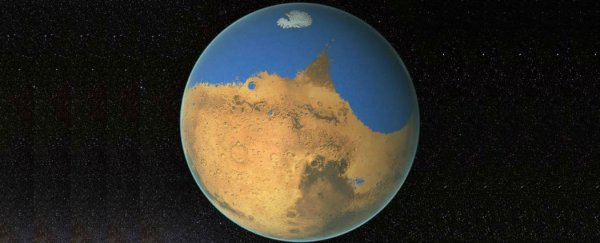Scientists at NASA have measured signals from ancient water on Mars to estimate that 4.3 billion years ago, there was probably enough water to cover the entire Martian surface in a layer about 137 metres deep. More likely, this water accumulated in an ocean bigger than the size of Earth's Arctic Ocean, covering almost half of Mars's northern hemisphere. This means at its deepest point it would have reaching down to more than 1.6 kilometres. And yep, that's about as much water as you'd need to make an ideal environment for life.
"Our study provides a solid estimate of how much water Mars once had, by determining how much water was lost to space," lead researcher Geronimo Villanueva, from NASA's Goddard Space Flight Centre in the US, said in a press release. "With this work, we can better understand the history of water on Mars."
We know that water must have flowed across part of the Martian landscape at one point, because its sandy desert plains still carry the swirling marks it left behind. But just how much water hasn't been an easy question to answer.
To figure this out, Villanueva's team worked with the world's most powerful infrared telescopes, the European Southern Observatory's Very Large Telescope in Chile, and the W.M. Keck Observatory and NASA Infrared Telescope Facility in Hawaii, which allowed them to calculate the chemical signatures of two different forms of water in Mars's atmosphere. One of these was just plain old H2O, but the other was HDO, or 'heavy water', which contains much more of the hydrogen isotope deuterium. While normal H2O is lost by Mars to outer space, the heavy water remains trapped in the Martian atmosphere.
They calculated the ratio of both types of water across different seasons and areas on Mars. From this, they created an atmospheric map throughout a period of six years - or three years in Mars time - to recreate the microclimates and seasonal changes that would have occurred in Mars's early years.
"The compelling evidence for the primitive ocean adds to an emerging picture of Mars as a warm and wet world in its youth, which trickled with streams, winding river deltas, and long-standing lakes, soon after it formed 4.5 billion years ago," Ian Sample writes for The Guardian.
Publishing the results in Science, the researchers describe how they looked at the ratio of H2O and HDO in the planet's north and south poles to find that they contained a significant amount of heavy water, which means these areas have lost a "tremendous" amount of H2O. How much? They've calculated that Mars must have lost a volume 6.5 times larger than the volume in its polar caps now, which means the ocean on early Mars must have held at least 20 million cubic kilometres.
"With Mars losing that much water, the planet was very likely wet for a longer period of time than was previously thought, suggesting it might have been habitable for longer," one of the team, Michael Mumma, said in the press release.
It's discoveries like this that draw us, inch by inch, closer to a time when we might actually be able to recreate what life might have looked like on this once-temperate planet. And then eventually, what fate it met before the planet descended into the hostile, wind-swept desert it's now become. Scientists, we're counting on you!
